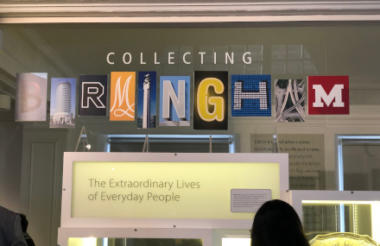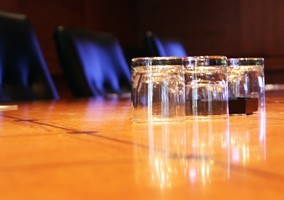If you visited Birmingham Museum in the first half of 2016, you probably had the privilege of seeing what is believed to be the oldest Qur’an in the world, when it was on display in the centre of the museum’s new Faith in Birmingham Gallery. This Qur’an, which is owned by the Cadbury family, has been carbon dated to within ten years of the life of the Prophet Muhammad. The ancient manuscript could only be displayed in the museum for six months because of the risks of light exposure so, after the exhibition ended, the museum’s curators were left with the question of what objects should replace the Qur’an in the new gallery to reflect the significance of the Islamic faith to the people of Birmingham.
At the time, the museum was a year into a three-year project called Collecting Birmingham, which was the brainchild of the charity’s director, Dr Ellen McAdam. When McAdam joined Birmingham Museums Trust in 2013 from Glasgow Museum, she was struck by the absence of items on display that reflected post-WWII Birmingham and particularly its working-class and immigrant communities. “Let’s just say there are a lot of pre-Raphaelites in the collection here,” she says wryly.
There was also no tradition in Birmingham of citizens donating objects to the museum unless they were very wealthy. “If you cleared out your grandmother’s attic in Glasgow and you found your grandfather’s medals, your first thought was to give these to the museum,” explains McAdam. “But this wasn’t happening in Birmingham, especially not within the immigrant communities because they didn’t trust the museum service.” The bottom line was that the exhibitions and collections in the museum’s venues were not representative of the city’s diversity, and neither were its visitors.
“Birmingham used to have a reputation in the UK cultural sector for playing it safe with its programming,” McAdam adds. “It was always heavily dominated by fine art. There was not enough, in my opinion, about local history and local issues. I felt very strongly that the museum hadn’t been representing the real Birmingham.”
She was determined to change this, not only for reasons of principle and progress, but also to put the museum on a more sustainable financial footing. Birmingham Museums Trust had been converted to a charity in 2012 and its funding from Birmingham City Council was gradually reducing, so it needed to replace this with earned income. However, McAdam was to encounter resistance to her plans from both internal and external sources.
“One of the first things we did was to install a children’s gallery next to the tearoom, because we knew that would appeal to family visitors. Some members of staff were so outraged by this they left, because they said children don’t belong next to the art. But where are the visitors of the future going to come from? Similarly, although it’s the principled thing to do to try to attract more diverse audiences, it’s also good business sense because, by the time of the next census, 50 per cent of Birmingham’s population will be BAME.”
However, when the curatorial teams began reaching out to Birmingham’s communities to explore what sort of items the museum should acquire to better reflect the lives of its diverse population, they came up against a distinct lack of goodwill. Curators became aware that people did not trust the museum, largely because previous attempts to engage with them had been piecemeal and clumsy, and objects that had been donated in the past had not been treated with care and respect.
Rachel Cockett, the museum’s director of development, admits: “I’ve worked here since 2000 and, if you’d asked us in 2000 if we were representative of the people in the city, we’d have said yes. It’s true there were lots of projects aimed at representing and collecting from people in the city, but the projects remained just that – projects. Staff would leave and the collected items wouldn’t be fully documented, the relationships would drift and, by the time we got more funding for another community project, we’d be treated with much more caution by the people we wanted to work with.”
Collecting Birmingham
Staff realised that if they genuinely wanted the museum to reflect the city’s multicultural and socioeconomic diversity, they needed to deconstruct its outdated, colonial attitude to collecting and adopt a new approach that addressed ethical questions around power and value in the process of collecting objects and interpreting people’s lives. They applied to the Heritage Lottery Fund for a grant to underpin this work and, in 2015 ,were awarded £500,000. The Collecting Birmingham project was born, with the theme “Growing up, living and working in Birmingham”.
The project focused on four groups that had been under-represented: the Caribbean, Muslim and LGBTQ communities, and people under 25. Over the next three years, the trust worked hard to rebuild relationships and engage new audiences in the city. More than 3,500 people were consulted at 83 events, open days and workshops and, by the end, the trust had acquired, through purchase and donation, more than 1,800 new objects – against an initial target of just 40.
Faith in Birmingham Gallery
It was through consultation events that curators settled on the two items that would succeed the ancient Qur’an display and represent Islam in the Faith in Birmingham Gallery. Dr Rebecca Bridgman, curatorial and exhibitions manager, knew that Christie’s was about to hold a sale of Islamic art and artefacts. She contacted Birmingham City Mosque and asked if it would allow the museum to conduct a consultation event among the congregation.
“Previously, we’d done consultation events only at the museum so it was a big step change for us to go out into the community and do it there,” Bridgman says. “We took photographs of the objects that were coming up for auction and set up a stall outside Friday prayers at the mosque where we invited people to vote for the objects they wanted us to buy. Then we went back the next day and did a more in-depth consultation where we explained a bit more about each of the items.”
Two of the objects that worshippers selected were an Ottoman Qibla indicator, an instrument used by Muslims to determine the direction they should face for their prayers, and a 19th century French replica of a 14th century Egyptian glass lamp. Says Bridgman of the latter: “I thought this was a real outsider that people wouldn’t necessarily be interested in, but what people told us at the consultation was that they liked the idea of a French imitation because they knew it wasn’t stolen from any mosque.”
These acquisitions were the first purchase of Islamic art for Birmingham’s collection in a century and, even though Collecting Birmingham has now ended, the items continue to take pride of place in the Faith in Birmingham Gallery. “Birmingham is one of the most faithful cities in the UK, with over 75 per cent of the population identifying with one faith or another, so that was the idea behind this gallery,” Bridgman explains. “We didn’t just want it to be about faith, we wanted it to be about faith in Birmingham, and it was the first gallery where we worked with communities in the city from the very start – we established a working group that helped us design the gallery and identify the themes within it.” Other items on display include the Sultanganj Buddha, a Bahá’i marriage certificate, a T-shirt belonging to a local Rastafari child and the uniform of a Christian street pastor.
The relationship with Birmingham City Mosque has endured too: museum staff are now liaising with the mosque committee to purchase a collection of items related to Pakistani sport.
Knights of the Raj exhibition
In another triumph for Collecting Birmingham, the museum worked with acclaimed Birmingham street artist Mohammed Ali on an exhibition called Knights of the Raj.
Ali had been engaging with the trust as an artist for over a decade and, when he was invited to curate an exhibition that celebrated Birmingham curry houses and the Bangladeshi families that ran them, he jumped at the chance.
“This was very personal to me,” he says. “My late father was one of those Bangladeshi migrants who was part of the historic curry trade that transformed British cuisine. They were mostly single men who arrived here in the 60s, established these restaurants and then married local women or brought wives here from Bangladesh.”
But, even for Ali, it wasn’t easy to gain the trust of families from that community, and he invested a lot of time using his and his father’s connections to build relationships with restaurant owners past and present to get their views on what sort of objects the museum should display to represent their lives and their stories.
A breakthrough came one day as he was passing the Koh-I-Noor restaurant, which had opened in the 1970s but closed in 2016 for refurbishment. Ali saw that the premises were being gutted and the interior thrown into a skip. “I realised that this old-fashioned, 70s-style restaurant was being ripped apart and it was a perfect opportunity for us to preserve it as part of Knights of the Raj and Collecting Birmingham. We literally climbed into the skip and started hauling things out.”
Rebecca Bridgman takes up the story: “I remember getting this call from Mohammed on a Wednesday night saying ‘we’ve got to get into this restaurant because they’re tearing it apart’. So we used some money from Collecting Birmingham to hire some freelance technicians to come in and cut out one of the booths and, somehow, they managed to get it out through the back door.”
The booth was reassembled in the Knights exhibition at the museum. Rolls of wallpaper found at the restaurant were applied to the walls, the rescued carpet was relaid and the table was set with tableware recovered from the skip.
In the end, dozens more objects were also collected for Knights of the Raj, including photographs, menus and a service trolley and, after the exhibition closed in Birmingham, it went on temporary display at the Museum of Food and Drink in New York. Today, the Koh-I-Noor booth remains in Birmingham’s permanent collection and Mohammed Ali has subsequently joined the trustee board of Birmingham Museums Trust.
Messy collecting
Rachel Cockett recalls: “It took a really long time to collect from some of the communities in this project. The act of acquisition could be felt to be oppressive. When groups feel oppressed or subject to racism, they are uncomfortable with the authority of institutions, and that means we have to take a long time – and in some cases are still taking a long time – to build those relationships.
“We’re now taking a much more informal approach to collecting, which one of the team refers to as ‘messy collecting’. We’ve learned that sometimes it’s OK not to collect anything, but to have developed relationships which will stand – relationships which bring a lot of goodwill and powerful ambassadors who will talk about what we do and share their experience of working with us. And in time, who knows, that may lead to collecting.”
The lessons learned from Collecting Birmingham have prompted the trust to permanently change its policy on how it interacts with its audiences and collects objects for its venues. Bridgman says that while handing control over to people outside the museum was “quite a scary process, you do have to experience it to realise how valuable it is”.
“I think people in the organisation now have really shifted their thinking,” she says. “I can’t see us ever going back to a situation where just the curators decide what we should have in an exhibition. Instead of asking ‘what should we have in this exhibition?’, now we say, ‘who should we ask what we should have in this exhibition?’ That’s the difference.”
Humility
Su Sayer, chair of the Charity Awards judges, describes Collecting Birmingham as “a shining example of a charity that had the humility to admit they weren’t connecting with their audiences, and that they needed to radically change their approach”.
“There are so many lessons here for the broader charity sector around giving up power and valuing lived experience as well as professional expertise.”
The process was indeed unsettling for many museum staff, McAdam recalls. “Collecting Birmingham was difficult – there were a lot of staff who really didn’t want to do it. But having done it and survived, it changed people. It was a transformational experience.”
The new approach is also having an impact on audience diversity, she says: “Diversity in this building is rising – it’s now at 20 per cent BAME visitors, though that’s still not as high as we’d like. What we’re having more difficulty with is recruiting staff from diverse backgrounds, and that’s partly because museums are perceived, quite correctly, as being insecure and badly remunerated. But that will change in time.” The trust is also trying to improve the diversity of its trustee board, initially by establishing a series of advisory panels that it hopes will provide a pipeline of diverse talent for the main board.
Going forward, McAdam and her team are developing a suite of training for other cultural institutions to share the lessons learnt from Collecting Birmingham, and she is sure that winning the Charity Awards will help to give credibility to that. She also wants to make connections with other under-represented communities in the city, particularly white working-class people.
Awards judge Lynne Berry suspects that the process of freeing the museum from local authority control and converting to a charity seven years ago had more of an impact than even the museum team gives credit for. “It may not have been a consciullous shift, but I think there is something here about a different agenda, about needing to demonstrate a connection to your public in a different way,” says Berry. “Once you stop being an inward-looking public body that protects and you become a charity that looks outwards and enables, you see everything very differently.”
Applications for the Charity Awards 2020 are now open.
|
Related articles












